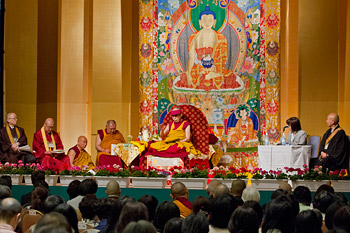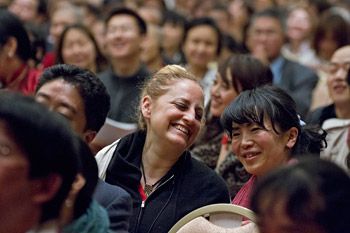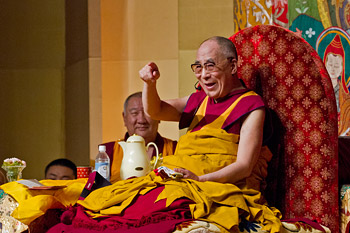Tokyo, Japan, 17 April 2014 - The 1200 people who gathered to listen to His Holiness the Dalai Lama teach in Tokyo today were mostly Japanese, but also included Koreans, Mongolians and Chinese, some from Taiwan and some from China. To begin with His Holiness explained what would be recited at the beginning, a verse of Pali, the Heart Sutra in Japanese and the verses of salutation from Nagarjuna’s’ Fundamental Treatise on the Middle Way’ and Maitreya’s ‘Ornament for Clear Realization.

|
His Holiness the Dalai Lama speaking during his teaching in Tokyo, Japan on April 17, 2014. Photo/Office of Tibet, Japan
|
“Here we are in Japan,” His Holiness remarked, “where Buddhism has flourished for centuries, where the Perfection of Wisdom teachings are popular and recitation of the Heart Sutra is widespread. There are various ways of giving teachings: the teacher can give a transmission with explanation or without. There’s also a method by which explanation is given every day and the students go over it and reflect on what they’ve heard and there is also a tradition by which the student reviews what she has heard until she’s understood it and then seeks further explanation. On this occasion I’ll be giving a transmission, a reading, of the Heart Sutra with some explanation and then read through Nagarjuna’s ‘In Praise of Dharmadhatu’ and Thogme Sangpo’s ‘Thirty-seven Practices of Bodhisattvas’ with some clarifications.”
First of all, he reviewed Buddhism’s place in the context of world religions. He spoke of religions with and without philosophical background and those that believe in a creator those that do not. Of the latter, Jainism emerged in India 2600 years ago and Buddhism appeared 30-40 years later. While Jains and non-theistic Samkhyas assert the existence of a self-sufficient and autonomous self apart from the psycho-physical aggregates, Buddhists do not. Buddhists believe that experience of pain and pleasure is not without cause, but the causes and conditions involved are of our creation. The person who experiences pain and pleasure is merely designated on the basis of the aggregates.
In the context of selflessness, the lower Buddhist schools, the Vaibhashikas and Sautrantikas only speak of a selflessness of persons, whereas the Chittamatrins and Madhyamakas also assert the selflessness of phenomena. His Holiness recalled attending an inter-religious meeting in Amritsar, India at which a Sufi teacher observed that all religions deal with three questions: What is the self? Does it have a beginning and does it come to an end? Buddhism asserts that self is designated or labelled on the basis of the 5 psycho-physical aggregates. For those who believe in a creator god, self begins when he creates it anew. For Buddhists principal of the five aggregates is consciousness and self is designated on the basis of consciousness.

|
Some of the over 1200 people attending His Holiness the Dalai Lama's teaching in Tokyo, Japan on April 17, 2014. Photo/Office of Tibet, Japan
|
Things that come and go are subject to change and arise from a cause. The substantial cause of consciousness is a previous consciousness therefore consciousness has no beginning, nor does it have an end. Thus, the self that is designated on the basis of it is without beginning or end.
His Holiness digressed to talk about the difference between religion and science. Until recently conventional science regarded consciousness as simply a function of the brain. While religion had something to do with the mind, science was by and large concerned with material things, things which can be measured. However, scientists too have minds, experience joy and sorrow, love and compassion. And religious practitioners need material facilities like food, clothes and shelter. In the late 20th and early 21st centuries neuroscientists began to recognise that mind has an impact on the brain, that mental training, for example, affects the brain. Links between science and Buddhist science have become closer.
His Holiness pointed out that the Buddha was once like us, but because he trained his mind over a long stretch of time he became enlightened. We too can transform our minds and the tool we use to transform it is the mind.
‘Thus have I heard at one time, the Bhagavan was dwelling on Vulture’s Peak ...’ is the way the Heart Sutra opens. His Holiness clarified that the reference to monks can sometimes mean Arhats and when it says the Buddha was absorbed in a concentration called ‘Profound Illumination’, the word profound refers to emptiness, while illumination refers to dependent origination. It is in this context that the 5 aggregates are described as also empty of inherent existence. Because ignorance permeates all disturbing emotions, explanation of selflessness should be given right from the start.
Speaking about his own experience His Holiness said:’
“I make no claim to anything special, but I have taken an interest in emptiness since I was 15 or 16 years old. At around the age of 30 I thought a lot about the self’s being neither one with nor separate from the aggregates and I had a strong sense of the absence of self. When I applied the same reasoning to the aggregates I didn’t have the same kind of experience. I’ve met people who told me that Nagarjuna’s explanation of emptiness and dependent origination is a kind of intellectual exercise with little practical application. This clearly isn’t true.

|
His Holiness the Dalai Lama speaking during his teaching in Tokyo, Japan on April 17, 2014. Photo/Office of Tibet, Japan
|
“Things have no inherent existence, but that is not to say there is nothing there. They only exist in dependence on other factors. Form is empty, empty of inherent existence; however, what appears to us gives no impression of this. This is not unlike the Quantum Physics approach because if you break things up into their parts, there’s nothing there that you can point to as inherently existent.
“Take this flower in front of me, if we look for it in its colour and shape down to its smallest particles, we don’t find anything that is the flower. It is a dependent origination to which we give the name flower. Meanwhile, no one will deny that there is a flower here, however, as my friend Aaron Beck says, 90% is our own projection.”
His Holiness explained how the mantra or dharani at the end of the Heart Sutra represents the path of spiritual development. The first two words ‘Gate, Gate’ refer to the paths of accumulation and preparation. ‘Paragate’ refers to the path of seeing on which emptiness is first seen directly. ‘Parasamgate’ refers to the path of meditation, while ‘bodhi svaha’ refers to the path of no more learning and the enlightenment of a Buddha.
His Holiness read briskly through ‘In Praise of Dharmadhatu’ and ‘Thirty-seven Practices of Bodhisattvas’ highlighting points here and there. At the end he said:
“The texts have been printed in a booklet and I’ve given you a preliminary explanation. Now it’s up to you to read them again and think about what they say. Study them. If I’m back in a year’s time and I examine you on this, I want to see that these booklets have become dark with use.
“I’ve been in Japan for two weeks beginning with prayers in Sendai led by Shinto priests. I’ve met many of my Japanese friends here and there; I hope you too have felt it was of some benefit. Now, you must apply your minds to think about what I’ve just taught. One Tibetan Lama advised that even if you knew you were going to die tomorrow, it would be worthwhile continuing to study, because it would be like an investment for the future.”
Ven. Fujita-san, Principle of Koyasan University offered words of thanks, which was met by warm applause and His Holiness made his way slowly out of the hall as smiling people pressed forward with outstretched hands to catch his as he passed.
Tomorrow His Holiness flies back to India. 